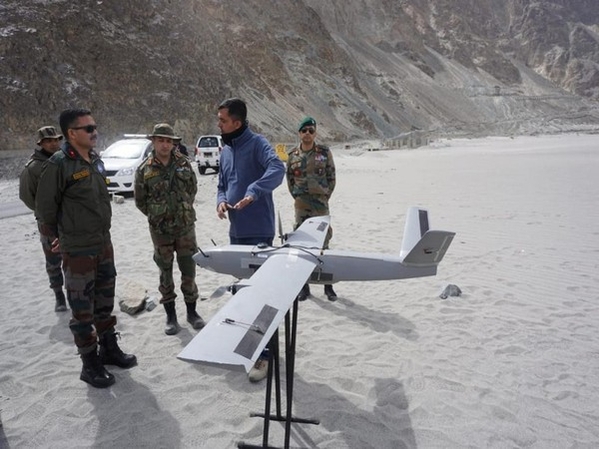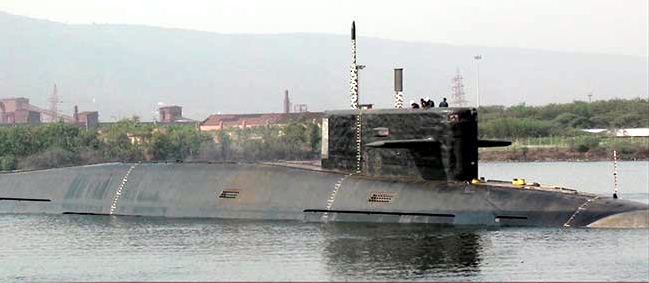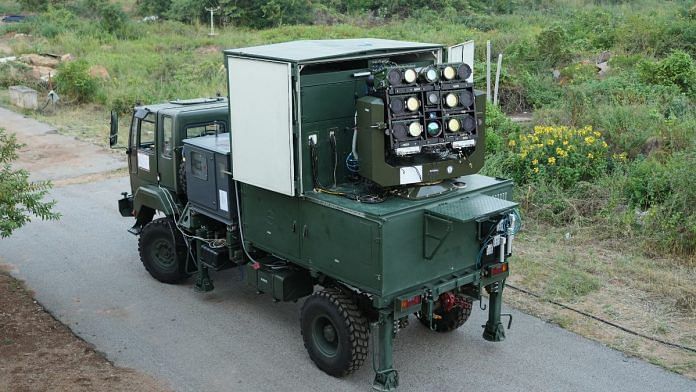SOURCE: AFI


The Indian Army has begun deploying loitering ammunition along the Line of Control (LoC) in response to a recent surge in Pakistani Army-assisted attempts to infiltrate terrorists into the Kashmir Valley. This strategic move, reported in early April 2025, aims to counter the escalating cross-border threats, particularly in sectors like Krishna Ghati and Akhnoor, where Pakistan’s Border Action Team (BAT) and terrorist groups have intensified their activities.
Loitering munitions, often dubbed “kamikaze drones,” offer a new layer of precision and persistence to India’s border security, reflecting a shift toward advanced technology to tackle asymmetric warfare. This article examines the deployment, its operational significance, and the broader context of India-Pakistan tensions along the LoC.
Continue readingSOURCE: AFI


Pipavav Shipyard, India’s largest shipbuilding facility located in Gujarat, is poised for a remarkable comeback under the stewardship of Swan Defence and Heavy Industries Ltd (SDHI), formerly Reliance Naval and Engineering Ltd. Vivek Merchant, Director of SDHI, recently announced that the shipyard is on track to resume shipbuilding operations within a couple of months, marking a significant milestone in its revival after years of financial and operational challenges.
Since SDHI took control of the shipyard on January 4, 2024, following its acquisition through a National Company Law Tribunal (NCLT) resolution process, the facility has already demonstrated its capabilities. Merchant highlighted the completion of repair and refit work on four vessels, including three for the Indian Coast Guard. “We actually completed three Coast Guard vessels. These are Fast Patrol Vessels (FPVs) and Offshore Patrol Vessels (OPVs). OPVs are the Coast Guard’s largest ships. So, we can now repair two OPVs. I think that is a good demonstration,” Merchant said. Notably, all three Coast Guard refits were delivered ahead of schedule, underscoring the shipyard’s renewed efficiency.
Continue readingSOURCE: AFI


In a bold step toward global expansion, Bengaluru-based space technology startup Bellatrix Aerospace has announced plans to establish a propulsion systems manufacturing facility in Delaware, USA, to serve the burgeoning U.S. commercial space market. The move, unveiled on April 11, 2025, underscores India’s growing influence in the global aerospace sector and positions Bellatrix as a key player in sustainable space propulsion technology.
Bellatrix has already secured a significant partnership by signing a Memorandum of Understanding (MoU) with a prominent U.S. satellite manufacturer, positioning itself as their preferred propulsion partner. While details of the partner remain undisclosed, this collaboration highlights confidence in Bellatrix’s innovative technologies, which include high-performance green propulsion systems and electric Hall-effect thrusters. These systems, known for their reliability and cost-efficiency, are tailored to meet the demands of modern satellite constellations.
Continue readingSOURCE: IDRW.ORG


The Center for International Strategic Studies (CISS), a prominent Pakistani think tank, has called on the Pakistani government to oppose the recent approval by the U.S. Department of Energy (DOE) allowing Holtec International to transfer Small Modular Reactor (SMR) technology to India. The decision, announced in early 2025, enables India to design and construct advanced SMRs, raising concerns in Islamabad about the potential military implications, particularly for India’s nuclear submarine programs.
SMRs, compact nuclear reactors with a capacity of up to 300 MW, are designed for diverse applications, including electricity generation, industrial use, and marine propulsion. Their smaller size and modular construction make them ideal for environments requiring high efficiency and limited space, such as submarines. The CISS argues that this technology transfer could significantly enhance India’s ability to develop more efficient reactors for its Strategic Submarine Ballistic Nuclear (SSBN) and Nuclear-Powered Attack Submarine (SSN) programs, thereby strengthening its naval deterrence and power projection in the Indian Ocean Region (IOR).
Continue readingSOURCE: IDRW.ORG


The Indian Air Force (IAF) has issued a call to private sector companies to design and develop indigenous Main Rotor Blades for its fleet of Mi-17 helicopters, a workhorse in its rotary-wing operations. These helicopters, available in variants like the Mi-17 V5, serve critical roles in troop transport, disaster relief, and combat support across India’s diverse terrains.
However, the Main Rotor Blades—vital for lift and maneuverability—come with a limited Total Technical Life (TTL), lack an overhaul option, and require frequent replacement as mandated by the Original Equipment Manufacturer (OEM), Russia’s Mil Moscow Helicopter Plant.
Continue readingSOURCE: AFI


In a significant boost to the Indian Navy’s modernization efforts, German engine manufacturer MAN Energy Solutions (MAN ES) has secured a contract to supply advanced propulsion packages for five new Fleet Support Ships (FSS). The deal, signed with Hindustan Shipyard Limited (HSL), underscores India’s commitment to enhancing its maritime capabilities with cutting-edge technology. Announced on April 15, 2025, this contract marks a milestone in the Indian Navy’s journey toward self-reliance and operational excellence.
The contract includes the delivery of ten 20V32/44CR marine engines, which will serve as the heart of the propulsion systems for the five FSS vessels. These engines, among the largest ever supplied to the Indian Navy, are complemented by main reduction gearboxes, shaft generators, bow thrusters, and MAN Alpha Navy Controllable Pitch Propeller (CPP) systems. The 32/44CR engines are renowned for their reliability and efficiency, making them a trusted choice for medium-speed marine diesel applications in naval fleets worldwide.
Continue readingSOURCE: AFI


India has solidified its place among the world’s leading defense innovators with the successful development of the Gaurav, a 1,000 kg-class Long-Range Glide Bomb (LRGB) that stands out as one of the few purpose-built heavy glide bombs globally. Designed and developed by the Defence Research and Development Organisation (DRDO), Gaurav combines advanced GPS-guided precision with an impressive 100-kilometer range, setting a new benchmark for India’s indigenous defense capabilities. Conducted between April 8-10, 2025, its recent trials from a Su-30 MKI fighter jet demonstrated pinpoint accuracy, marking a significant leap for the Indian Air Force (IAF).
Unlike most glide bombs, which typically fall into the 500 kg category due to the aerodynamic and structural complexities of heavier designs, Gaurav’s 1,000 kg payload places it in an elite class. Its closest counterparts include the U.S.-made Joint Direct Attack Munition-Extended Range (JDAM-ER) and Israel’s SPICE-2000, both renowned for their precision and extended reach. However, Gaurav’s fully indigenous development, involving DRDO’s Research Centre Imarat, Armament Research and Development Establishment, and industry partners like Adani Defence and Bharat Forge, underscores India’s growing self-reliance in cutting-edge military technology.
Continue readingSOURCE: AFI


India’s quest for self-reliance in aerospace technology hinges on the successful development of indigenous jet engines, a domain where the Gas Turbine Research Establishment (GTRE), under the Defence Research and Development Organisation (DRDO), has been striving for decades. The Kaveri engine program, its successor Kaveri 2.0, and the ambitious Advanced Medium Combat Aircraft (AMCA) engine project are pivotal to reducing India’s dependence on foreign engines. A critical enabler for these programs is a dedicated Flying Testbed (FTB), a specialized aircraft used to evaluate engine performance under real-world flight conditions.
With Tata Group-owned Air India auctioning its last Boeing 747 (registration VT-ESO) on May 6, 2025, in Mumbai, the question arises: Should GTRE seize this opportunity to acquire the aircraft as an FTB for its engine development programs?
Continue readingSOURCE: AFI


The recent downing of Ukrainian Su-27 and F-16 jets by Russia’s S-400 Triumf air defense system has sent ripples through global defense circles, serving as a potent reminder of the system’s formidable capabilities. For the Pakistan Air Force (PAF), heavily reliant on its aging fleet of F-16s and JF-17s, this development underscores a critical reality: approaching India’s borders, fortified by the same S-400 systems, has become a near-impossible task.
India’s strategic deployment of the S-400 along its western frontier demands a serious recalibration of Pakistan’s aerial tactics, as the system’s proven lethality redefines the subcontinent’s air defense dynamics.
Continue readingSOURCE: AFI


Recent statements from Pakistani military leaders and politicians reveal a troubling narrative: a call to lead Arab forces in a supposed conquest to reclaim what they term “Islamic land” from Israel and India, dismissing the two-state solution for Palestine and framing Kashmir as a religious battleground. This rhetoric, rooted in ideological fervor rather than strategic reality, exposes a fallacy in Pakistan’s military thinking—that it can succeed where Arab coalitions have failed over seven decades against Israel, while simultaneously challenging India over Kashmir. Such ambitions risk overextending Pakistan’s capabilities, misreading global geopolitics, and plunging the region into deeper instability.
Pakistan has historically supported the Palestinian cause, advocating for a state based on pre-1967 borders with East Jerusalem as its capital. However, recent pronouncements from military figures, including corps commanders’ meetings reported on April 4, 2025, express “complete solidarity” with Palestinians while condemning Israel’s actions as “war crimes.” More alarmingly, some statements from political and religious leaders, like those at Jamaat-e-Islami rallies, imply a rejection of the two-state solution, favoring a total reclamation of Palestinian territory as “Islamic land.” This aligns with a broader narrative of leading a pan-Islamic military effort against Israel, a role Pakistan’s army seems increasingly eager to embrace.
Continue readingSOURCE: RAUNAK KUNDE / NEWS BEAT / IDRW.ORG


The Indian Air Force (IAF) has formally requested 40 additional Rafale fighter jets through a government-to-government (G2G) deal with France’s Dassault Aviation, according to a recent report by the Bharat Shakti portal. This acquisition would bolster the IAF’s existing fleet of 36 Rafale jets, inducted between September 2020 and 2022, bringing the total to 76 units.
However, this move, while addressing immediate operational needs, falls short of the IAF’s earlier demand for 126 Rafales and casts uncertainty over the long-delayed Multi-Role Fighter Aircraft (MRFA) tender for 110 jets. With the IAF also committed to procuring 97 more Tejas Mk1A jets and potentially up to 200 Tejas Mk2 units, the future of the MRFA tender and the IAF’s fighter fleet composition remain under scrutiny.
Continue readingSOURCE: RAUNAK KUNDE / NEWS BEAT / IDRW.ORG


The Defence Research and Development Organisation (DRDO) is set to take a significant step forward in its pursuit of advanced defence technologies by planning the development of an airborne Mega Watt (MW)-grade Directed Energy Weapon (DEW) soon.
According to DRDO officials, the organization has completed work on 2 kW and 5 kW DEW systems, which are likely intended for smaller-scale applications such as counter-drone or counter-UAV roles. Work on more powerful 25-50 kW systems is nearing completion, aimed at addressing larger threats like rockets or artillery shells. Additionally, DRDO is actively developing 100 kW and 300 kW DEW systems for naval warships and land-based applications, which could target aircraft, missiles, or ground assets with greater effectiveness.
Continue readingSOURCE: RAUNAK KUNDE / NEWS BEAT / IDRW.ORG


India’s quest for a robust naval aviation capability has taken a significant step forward with the Twin Engine Deck-Based Fighter (TEDBF), a project spearheaded by the Aeronautical Development Agency (ADA) in collaboration with the Indian Navy. However, questions linger about whether TEDBF will emerge as a true 5th-generation fighter or settle as a “5-Minus Class” deck-based platform. Recent insights from industry sources, as reported by idrw.org, reveal a complex decision-making process that led to prioritizing TEDBF over a naval variant of the Advanced Medium Combat Aircraft (AMCA).
Initially, the Indian Navy envisioned a carrier-based version of the AMCA, dubbed Naval-AMCA (N-AMCA), to leverage the 5th-generation stealth technologies being developed for the Indian Air Force. The AMCA, designed as a stealthy, multi-role fighter with internal weapons bays (IWB), supercruise, and advanced sensor fusion, promised significant commonality across services, potentially reducing costs. However, studies conducted by ADA and the Navy revealed critical limitations that undermined the feasibility of N-AMCA for carrier operations.
Continue readingSOURCE: AFI


In a landmark achievement for India’s defense capabilities, the Defence Research and Development Organisation (DRDO) successfully tested and showcased a 30-kilowatt (kW) laser-based Directed Energy Weapon (DEW) on April 13, 2025, at the National Open Air Range (NOAR) in Kurnool, Andhra Pradesh. This breakthrough, which demonstrated the weapon’s ability to neutralize aerial threats like fixed-wing drones, swarm drones, and surveillance sensors with pinpoint precision, has propelled India into an elite group of nations mastering advanced laser technology, alongside the United States, China, and Russia.
Developed by DRDO’s Centre for High Energy Systems and Sciences (CHESS) in Hyderabad, in collaboration with other DRDO labs, academic institutions, and Indian industries, the Mk-II(A) DEW system showcased its full spectrum of capabilities. The 30 kW laser, comprising six 5 kW lasers converging into a single high-energy beam, engaged targets at a range of up to 5 kilometers, inflicting structural damage and disabling sensors in seconds. Equipped with a 360-degree Electro-Optical/Infrared (EO/IR) sensor, the system ensures rapid, silent, and cost-effective neutralization of threats, with operational costs likened to “a couple of liters of petrol” per shot.
Continue readingSOURCE: AFI


The Indian Navy’s ambition to expand its fleet to 175–200 warships by 2035 is a bold vision, driven by the need to counter growing maritime threats, particularly from China’s expanding naval presence in the Indian Ocean. However, achieving this goal is increasingly at risk due to the Ministry of Defense’s (MoD) persistent preference for state-owned shipyards over private ones.
As highlighted in a 2022 Defense News report, the Indian Navy is unlikely to meet its fleet expansion targets due to funding constraints and the government’s bias toward public sector shipyards, which has left private players like Pipavav Shipyard (now under Swan Defence and Heavy Industries Ltd) struggling to secure contracts. It is time for the MoD to reverse this trend and actively encourage private sector shipyards to develop warships, leveraging their potential to boost capacity, innovation, and efficiency.
Continue reading